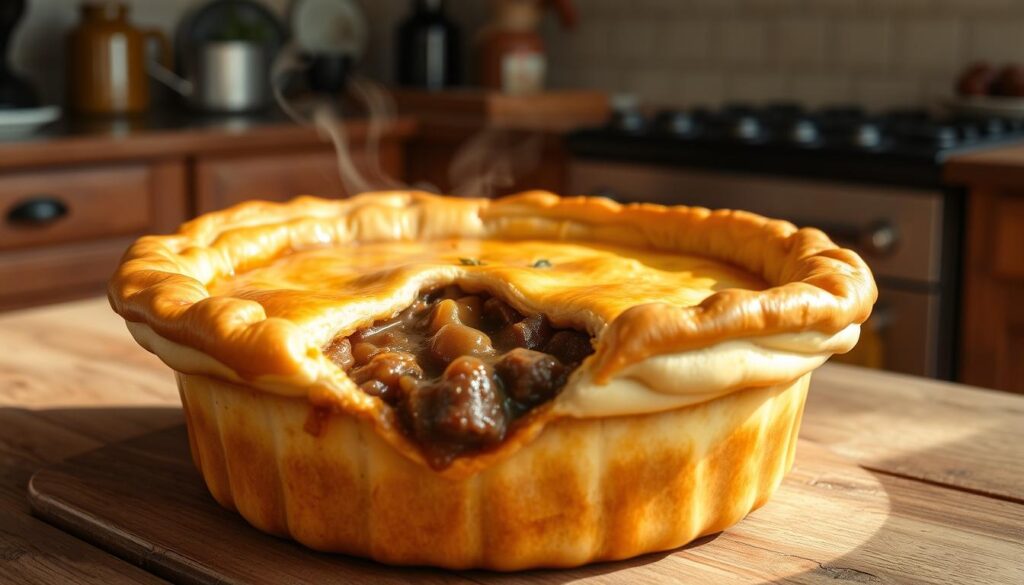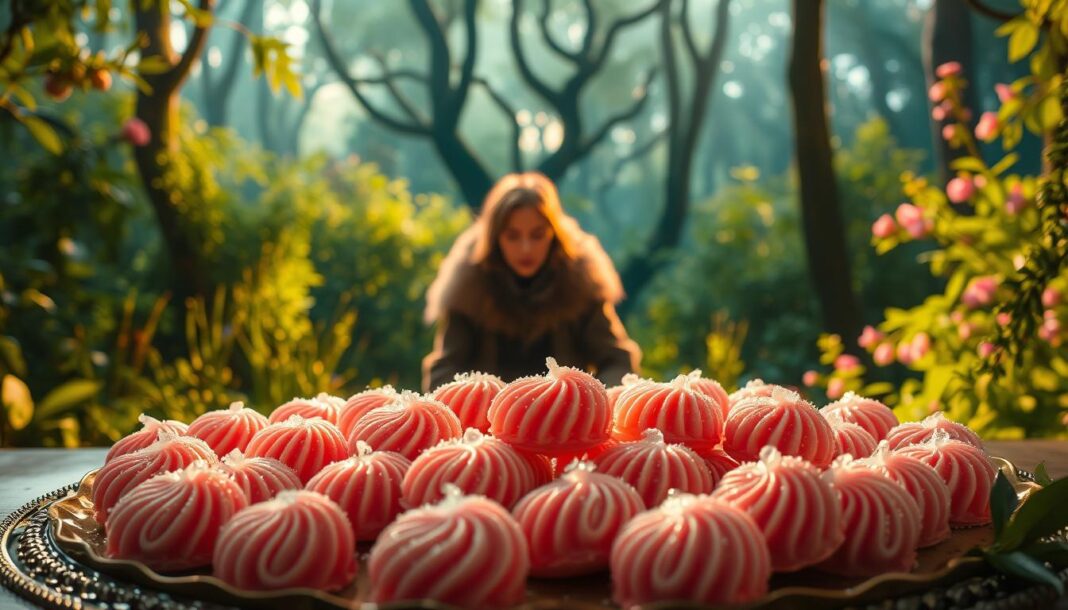We invite you to explore the rich flavors of a traditional British dish with our classic kidney pie recipe. This quintessential comfort food has stood the test of time, offering a savory filling encased in a flaky pastry crust.
At Historical Foods, we’re passionate about sharing the wisdom and knowledge behind beloved dishes like this one. Our comprehensive guide will walk you through the process of creating an authentic pie that’s sure to become a staple in your kitchen.
By mastering this recipe, you’ll not only gain a deeper appreciation for British cuisine but also acquire a versatile cooking skill that can be adapted to various ingredients and occasions.
The Rich History of British Kidney Pie
The history of British kidney pie is a rich tapestry woven with threads of necessity, cultural tradition, and culinary innovation. This traditional dish has been a cornerstone of British cuisine for centuries, providing sustenance during times of hardship and comfort during times of peace.
Origins in British Cuisine
The origins of kidney pie are deeply rooted in British culinary history, where meat pies have been a staple since medieval times. The use of kidney in cooking dates back to the 17th century, when offal was considered a delicacy among certain social classes. The combination of steak and kidney in a pie became a practical and flavorful way to utilize tougher cuts of meat, making it accessible to a wider population.
From Wartime Staple to Modern Comfort Food
During World War II, kidney pie gained prominence as a wartime staple due to meat rationing, which made organ meats a valuable protein source. As noted in historical culinary texts and referenced on platforms like Wikipedia, this period cemented kidney pie’s place in British cuisine. Over time, it transitioned from a necessity to a beloved comfort dish, reflecting changing attitudes toward traditional British cooking.
Today, kidney pie remains a cherished dish, with contemporary chefs adapting and elevating it while maintaining its essential character. Its presence in British literature, film, and popular culture has solidified its status as a cultural icon, fitting into the current trend of nose-to-tail eating and sustainable food practices.
Understanding the Perfect Kidney Pie Recipe
The art of creating a traditional British kidney pie lies in the details of its preparation. To achieve that perfect balance of flavors, we need to understand the core components and techniques involved.
What Makes an Authentic Kidney Pie
An authentic kidney pie is characterized by its rich, savory filling and flaky pastry crust. The key to this dish lies in the quality of its ingredients and the method of preparation. Using the right type of kidneys is crucial, as it directly impacts the flavor and texture of the pie.
Many recipes suggest soaking kidneys in milk or a vinegar solution to remove impurities and achieve a milder flavor. However, the choice of soaking method largely depends on personal preference.
Choosing the Right Kidneys
When it comes to selecting kidneys for your pie, you have several options: beef, lamb, or veal kidneys. Calves’ kidneys are considered the best due to their tender texture and mild flavor, but beef kidneys are more commonly used and offer a robust taste.
| Type of Kidney | Flavor Profile | Texture |
|---|---|---|
| Beef Kidneys | Robust, rich | Firm |
| Lamb Kidneys | Strong, gamey | Coarse |
| Veal Kidneys (Calves’) | Mild, tender | Soft |
Understanding the differences between these types will help you choose the best kidneys for your pie recipe.
Essential Ingredients for Traditional Kidney Pie
Let’s dive into the essential components that make up a traditional kidney pie recipe. The quality and selection of ingredients play a crucial role in the final flavor and texture of the pie.
Meat Components: Beef Chuck and Kidneys
The heart of a traditional kidney pie is its filling, made with beef chuck and kidneys. Beef chuck provides tender chunks of meat, while the kidneys add a rich, earthy flavor. When selecting kidneys, opt for fresh or properly stored ones to ensure the best taste.
Creating the Rich Gravy Base
A rich gravy base is essential for a flavorful kidney pie. This is achieved by using a combination of onions, beef broth, and sometimes red wine. The slow-cooked onions add a depth of sweetness, balancing the savory flavors of the beef and kidneys.
Perfect Pastry Ingredients
The pastry crust is a critical component of the kidney pie. For a traditional recipe, you’ll need 1 2/3 cups all-purpose flour, 1/4 teaspoon salt, 9 tablespoons cold unsalted butter (or a mix of butter and lard), and 2 to 4 tablespoons cold water. The ratio of flour to fat is crucial for achieving the perfect flaky texture. The cold water helps create steam pockets, resulting in a layered pastry.
Understanding the role of each ingredient helps in creating a superior kidney pie. For instance, the flour provides structure, while the salt enhances the overall flavor. The choice between all-butter pastry and a butter-lard combination affects the final texture and taste.
- The ratio of flour to fat is crucial for achieving the perfect texture.
- Cold water creates steam pockets, resulting in flaky layers.
- Salt enhances flavor in pastry, even in savory applications.
Preparing Your Kidney Pie Filling
The foundation of a great kidney pie lies in its rich and savory filling, which we will guide you through preparing. This crucial component requires careful attention to detail and a combination of quality ingredients and cooking techniques.
Cleaning and Preparing the Kidneys
Before you start cooking, it’s essential to properly clean and prepare the kidneys. This involves removing any membranes and cutting them into suitable pieces. Proper preparation ensures that the kidneys cook evenly and blend well with the other ingredients.
Browning the Meat for Maximum Flavor
Browning the beef is a critical step that enhances the overall flavor of the filling. To achieve this, melt 1 tablespoon of butter in a pan over medium heat. Add sliced onions and cook until they’re softened, then transfer them to a saucepan with the meat. Separately, fry mushroom slices in the remaining butter, turning them occasionally for a minute or two.
Developing the Rich Sauce
To develop the rich sauce, put the saucepan over medium heat and stir in flour, allowing it to cook for 3 minutes. Then, add tomato paste, bay leaf, and mushrooms. Pour in stock and beer, ensuring that the meat and vegetables are barely covered. Bring the mixture to a low simmer, covered, for 1.5 hours. Periodically skim off any excess fat that floats to the top to achieve a clean-tasting, silky sauce.
As the mixture simmers, the flavors will meld together, and the beef will become tender. Season with salt and pepper to taste. The slow cooking process is essential for developing the complex flavors that define a great kidney pie filling.
Crafting the Perfect Pastry Crust
The art of crafting the perfect pastry crust is a crucial element in creating an authentic British kidney pie. A good pastry crust not only adds texture but also enhances the overall flavor of the dish.
Making Flaky Butter Pastry
To make a flaky butter pastry, it’s essential to keep the butter cold and to handle the dough gently. The use of cold butter ensures that the pastry remains flaky, as it creates layers of dough and butter that expand during baking. When rolling out the pastry to 1/8-inch thickness, make sure it’s wide enough to cover your pie dish. The rolling direction and pressure can significantly affect the final texture, so it’s crucial to roll evenly without overworking the dough.
Rolling and Shaping Techniques
Once your pastry is rolled out, carefully place it over your pie dish, which should be brushed with water to help the pastry adhere. If using a pie funnel, position it in the center of the filling before covering it with pastry. Trim the edges to fit the rim of the dish, and then crimp them using your thumb and first finger to seal the filling inside. Proper venting is also crucial; cut a tiny hole or 3 to 4 slits in the center to allow steam to escape during baking, preventing a soggy bottom crust.
| Technique | Purpose |
|---|---|
| Rolling pastry to 1/8-inch thickness | Ensures even baking and prevents the crust from becoming too thick. |
| Brushing pie dish with water | Helps the pastry adhere to the dish. |
| Crimping the edges | Seals the filling inside and creates a decorative edge. |
| Cutting vents in the pastry | Allows steam to escape, preventing a soggy bottom crust. |
Step-by-Step Kidney Pie Recipe
Now that we have prepared our steak and kidney filling and crafted the perfect pastry crust, it’s time to bring our traditional British kidney pie together. This final stage is crucial in creating a dish that’s not only flavorful but also visually appealing.
Assembling the Pie
To assemble our steak kidney pie, start by filling the pie dish with the prepared steak and kidney mixture, making sure to fill it to the top. Then, cover the dish with the rolled-out pastry crust, pressing the edges to seal. Use a sharp knife to trim any excess pastry and create a decorative edge. Cut a few slits in the top crust to allow steam to escape during baking.
Brush the top of the pie with a beaten egg for a golden glaze. This not only adds color but also gives the crust a rich, pastry finish.
Baking to Golden Perfection
Place the pie on a baking sheet and bake in a preheated oven at 350°F (175°C) for about 25-35 minutes, or until the crust is golden brown. The filling should be hot and the crust should be flaky and well-cooked. If the crust browns too quickly, cover the edges with foil or a pie shield.
Resting and Serving Tips
Once baked, remove the pie from the oven and let it rest for at least 10-15 minutes before serving. This resting period allows the filling to set and the flavors to meld together, making it easier to slice and serve. When serving, consider traditional accompaniments like mushy peas or mashed potatoes to complement the rich flavors of the steak kidney pie.
For leftovers, cover and refrigerate the steak and kidney pie within 2 hours and consume within 3 days. To reheat, place the pie on a baking sheet and heat in a preheated 350°F oven for about 15 to 25 minutes, or until it reaches 165°F, the minimum safe temperature for leftovers.

Enjoying Your Homemade British Classic
Now that you’ve mastered the traditional British steak kidney pie recipe, it’s time to enjoy the fruits of your labor. Your beautifully baked steak kidney pie is perfect for special occasions or Sunday dinners, offering a rich and satisfying meal.
To make it a complete meal, consider pairing it with roasted vegetables or a fresh salad. You can also add personal touches like a dash of Worcestershire sauce or a sprinkle of fresh herbs to make the dish your own.
Pair your beef and kidney pie with a robust red wine or a traditional ale for a truly authentic experience.


